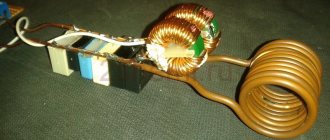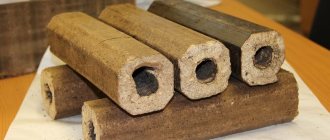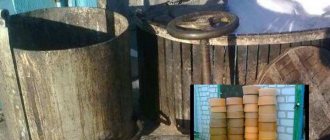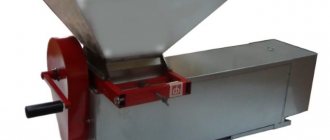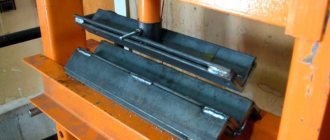Oil blower from fire extinguisher
On occasion, I took fire extinguishers to one organization to recharge. At the same time, I found out from a friend that there was a defective fire extinguisher that was going to be sold for scrap.
This defective fire extinguisher was the beginning of this project.
Step-by-step description of supercharger manufacturing:
1
.
First you need to take a decommissioned powder type fire extinguisher with a volume of 2-3 liters and empty its contents. 2
.
Next, you need to measure the PVC intake pipe of the fire extinguisher, taking into account the tightly screwed nozzle. If necessary, cut the tube to the required length, carefully and accurately. 3
. You need to take a new standard rubber tip for tubeless rims that have a spool.
4
.
Let's prepare a drill with a drill whose diameter corresponds to the internal groove of the tip. 5
.
Now, in the side of the body of the former fire extinguisher, you should drill a hole for the rubber tip. 6
. Next, metal shavings are removed from the fire extinguisher body, and the hole made is checked to see if there are burrs on it. If there is, take sandpaper and process it.
7
.
After this, taking the wire, you need to pull a rubber tip for tubeless discs from the inside of the body, which should fit tightly into the hole made with a groove. 8
. Let's start filling the tank with transmission oil.
9
. Now you need to assemble the supercharger and apply a pressure of 1-2 atmospheres to it with a compressor.
10
.
The device is ready for use. eleven
. We have a pleasant time operating the supercharger and enjoy the results obtained.
With this device, created on your own, oil will no longer flow on your hands and clothes.
Making an apparatus from elements of a refrigerator with a fire extinguisher
Homemade compressors are often used for airbrushes (devices for painting cars and other surfaces), so let’s consider making just such a device. The parts needed to assemble the structure can be borrowed from an old refrigerator and a regular fire extinguisher .
Tools and materials
To get started, you will need the following tools and units:
- fire extinguisher - OHP-10 or similar;
- pressure switch - RM-5 or with similar characteristics;
- moisture separating filter - 2 pcs;
- fuel filter - 1 piece;
- PVC hose with reinforcement;
- gearbox - preferably with a pressure gauge;
- separate pressure gauge for monitoring pressure in the receiver;
- Teflon tape (FUM);
- pliers, wrenches of different sizes.
Depending on the parts used, other tools may be required. Drawings of the fire extinguisher may also be useful to understand how to disassemble it.
Engine
For an average airbrush, a compressor motor from an ordinary household refrigerator is perfect.
Advice! It is advisable to use a fresher or well-maintained electric motor - without cracks or rust.
Air chamber
The container for collecting air will be made from an empty fire extinguisher. Its body has a relatively compact size, and the shape and material used for manufacturing are optimally suited to withstand significant air pressure for a long time.
To begin with, the fire extinguisher is emptied of its original contents in an open area, and then disassembled. Of all the parts, only the body itself and the lid, which is put on top, are left. In this form, the cylinder is fixed to the base of the future unit in any convenient way.
Assembly
Having all the necessary components available, the compressor unit is assembled directly.
Supercharger made from a plastic bottle
Many people know the situation when there is a problem with filling oil into a gearbox, transfer case, automatic transmission, etc. After thinking a little, I collected the necessary funds that were at hand and assembled the supercharger myself. At the same time, I remembered the program about crazy hands.
This device requires such components as a 5-liter plastic bottle, two valves, several fittings, and a metal tube.
To operate the supercharger, you need to fill it with 1 liter of oil, then connect a compressor - a car compressor will do - and increase the pressure to 2 kg/cm2. After this, close the air valve. Done, you can use the device. To do this, insert the hose into the filler hole of the gearbox and open the oil injection valve.
Under the influence of air pressure, oil enters the gearbox through a tube and hose. Within a minute, approximately 1 liter of oil is consumed.
After testing the bottle's critical burst pressure, it was determined that bursting would occur at a pressure of 4 kg/cm2.
Source
Solid oil blowers. Types, device, principle of operation
Manual solid oil blowers , as low-performance ones, are mainly intended for individual use and are included in the driver’s tool kit.
As an exception, small motor vehicles sometimes use lever-type solid oil blowers with mechanized filling.
Lever-type solid oil blowers are connected to the grease nipple using a collet tip 1, which ensures a tight connection of the solid oil blower with the grease nipple during lubrication. Lubricant is supplied to tip 1 through tube 2 and discharge ball valve 3 by plunger 5 driven by lever 11.
The cavity of the cylinder 4 under the plunger 5 is filled through hole 6 as a result of the vacuum created by the plunger during lifting. As the lubricant is consumed, it is compressed by piston 12, which is moved by the force of spring 8. To fill the lever solid oil blower, unscrew housing 9 from the front cover or remove rear cover 10; in this case, remove the piston 12 with the rod 7.
To mechanize the process of filling manual solid oil pumps, the front cover is equipped with an oiler with a check ball valve, through which lubricant is pumped using a tank with a manual pump. Lever solid oil blowers develop a lubricant pressure of 250–350 kg/cm2 with a force on the lever of 12–15 kg. The lubricant supply per stroke of the plunger is about 1 cm3, the useful capacity is up to 0.25-0.3 liters. The low productivity and insufficient pressure developed by manual solid oil blowers, as well as the high cost of physical labor of the lubricant during the working day, led to the need to mechanize this process.
Fluid replacement devices
To change the lubricant in a modern car, you need to have special installations. Such systems include:
Today there are gas stations that provide lubricant changes. Filling the car with gasoline is their immediate responsibility. But, in addition, the existing unique oil-changing equipment makes it possible to perform a lubricant change operation within 20 minutes. Service workers will replace:
In addition, they will check the injection system and pour new fluid into the gearbox.
Typically, to perform such work, gas station workshops use various compressors that create a vacuum.
Liquid is collected using a pneumatic method. For replacement, vacuum technology is used, which is characterized by simplicity, high speed, and environmental safety .
To replace automatic transmission lubricant, original equipment is used. The work is somewhat different from a regular operation. The replacement process is subject to automated control. Automation monitors the system pressure. After removing the liquid from the installation container, the system automatically switches to the ring mode.
The installation is connected to a car battery. Liquid dosing occurs automatically. The microcontroller monitors the process. The operator's hand does not take part in this work. The device operates in autonomous mode.
How to choose a grease blower?
A grease pump is a special device that allows you to coat hard-to-reach special parts that tend to rub against each other with lubricant inside the mechanisms of cars, tractors and many other mechanisms in the field of motor transport. Such devices are often found at service stations and at enterprises that are in one way or another connected with the activities of road transport.
This device has a very complex design, so it will be difficult for a beginner to choose. It is worth describing the most common types of grease blowers:
— Manual blower. The mechanism of the device is driven by a manual drive, which means it requires the application of physical force on the lever by the mechanic;
— Foot-operated lubrication pump. A similar design of the device is used to lubricate very large mechanisms, for which high pressure is used. Thus, the device will allow you to effortlessly lubricate the mechanisms of such giants as various combines, excavators, trucks, tractors and other moving large equipment in the motor transport sector;
— Pneumatic solid oil blower. This type differs radically from the previous ones, if only in that instead of the physical effort of a mechanic, a special device is used here - an air compressor. This type will be the best choice for industries that require constant support for mechanisms.
So, depending on your budget and needs, choosing the type of grease blower can be easily done. If you occasionally need to use the device, the first two types are suitable. The third type of device is suitable for doing business in the field of road transport.
The product description is for informational purposes only and may differ from the description presented in the manufacturer’s technical documentation. Recommend when buying check the desired functions and features.
You can report an inaccuracy in the product description - select it and click
Source
Types of oil superchargers
To replace the lubricating fluid, it is impossible to do without special oil fluid superchargers. These systems are mainly manufactured abroad. To work with grease, 2 types of installations are used:
To determine the level, the manual lubricant blower is equipped with an indicator. This device can be equipped with an electric drive. Grease is pumped into the vehicle after high pressure is created.
The manual oil pump is designed to supply fluid to the dispensing mechanism. The installation has a cylindrical container with a lid. To create pressure, there is an original pressure plate resembling a piston.
The industry produces various types of superchargers. Each model has a long service life, high quality, and excellent performance.
Manual superchargers have become very popular in automotive oil change shops. To carry out this operation you do not need to buy expensive equipment. The supercharger reduces operation time and increases the number of machines serviced within one hour. The cost of a manual supercharger directly depends on its manufacturer.
A special “funnel” shows on the display all the necessary information about the oil. According to the specified parameters, the master makes his decision on draining the liquid. Using a hose, the oil is drained through the drain neck into a container. The volume of such a special barrel reaches 60 liters. Then new lubricant is filled in
Development of a pneumatic solid oil blower
|
|
|
|
Main advantages of oil dispensing equipment
Almost every auto repair shop has such equipment. It makes it possible to quickly change the oil in the main mechanisms of the car:
Today you can buy models that are characterized by high performance, reliability and ergonomics.
The main advantage of such installations is ease of control. There is no need to hire additional personnel to operate these devices. However, they are expensive .
Using classical technology for transmission oil changes takes a very long time. A homemade oil supercharger, where pumping is done manually, is not used. Modern equipment allows you to reduce the time several times. When replacing, a pneumatic oil blower allows you to remove harmful mechanical deposits from the engine.
Some models have a preliminary chamber to determine the level of wear, as well as the volume of fluid. Usually the lubricant is changed through the hole intended for the dipstick.
There are models equipped with a special funnel. It is easy to drain the oil through it while under the car. To increase the speed of fluid replacement, install a pneumatic oil supercharger.
Oil dispensing systems are distinguished by high performance and the presence of various functions. The cost of such systems is quite high and is determined by the country of manufacture.
Source
Features of a piston supercharger
Upon superficial examination, the turbine compressor system is clear and quite simple, but this mechanism hides several important nuances in its design. It is the design features that allow this machine to work for a long time without interruption.
The mechanism must be constantly lubricated during operation. Due to high speeds, the rubbing parts (shaft, connecting rod and piston) quickly wear out, reducing performance. Oil supply to the system can occur naturally or forcefully. In the first case, the lubricant is picked up from the bottom of the crankcase by the protruding parts of the crankshaft and splashed along the inner walls of the mechanism. Refrigeration compressors use a circulation system that sucks in oil and circulates it through all components. In the case of forced supply, oil is sprayed throughout the compressor using a plunger pump (lubricator).
Communities › Do It Yourself › Blog › Supercharger of technical fluids.
I am planning to change the transmission oil in the Daewoo Matiz manual transmission. I decided to prepare. A supercharger was made from the available goods. I found out what it’s called after I made it, I also learned that there are a lot of such craftsmen among us and there are also an incredible number of options for superchargers. The only thing that makes me happy is the cost. I bought a hose clamp in the store - this is the asking price (15 rubles). The hose was presented by a friend, the used canister did not wait for the trash bin, the nipples were preserved from the times of the USSR. I will use a car compressor to create pressure. Taps and pressure gauges are not needed, I think so. Perhaps my experience will be useful to someone.
Improved handy DIY compressor
How to make a compressor that will not be inferior to the best Russian and foreign analogues? You will need the following parts:
Half of the components can be found in any garage.
Oil blower from fire extinguisher
This defective fire extinguisher was the beginning of this project.
Step-by-step description of supercharger manufacturing:
. First you need to take a decommissioned powder type fire extinguisher with a volume of 2-3 liters and empty its contents. 2
.
Next, you need to measure the PVC intake pipe of the fire extinguisher, taking into account the tightly screwed nozzle. If necessary, cut the tube to the required length, carefully and accurately. 3
. You need to take a new standard rubber tip for tubeless rims that have a spool.
. Now you need to assemble the supercharger and apply a pressure of 1-2 atmospheres to it with a compressor.
. The device is ready for use. 11
. We have a pleasant time operating the supercharger and enjoy the results obtained.
With this device, created on your own, oil will no longer flow on your hands and clothes.
My blog on drive2 https://www.drive2.ru/users/andron3030/
“Become part of the VKontakte community” - https://vk.com/texastv
Auto repair https://www.youtube.com/playlist?list=PLSVbQlAQoj8HGblXZDKm3KzwujI4gZiui
Subscribe to the channel https://www.youtube.com/channel/UC4nLdRx0Hibra_gFo6DiZKA?sab_cnfirmation=1
MY affiliate program on YouTube register https://join.air.io/TEXaSTV
do-it-yourself auto repairs
Video WHAT DID I MAKE FROM A BLOWTORCH? channel TEXaS TV
Honestly, I have quite enough syringes for pumping oil and grease, I even have an excess of them after I sold my Volga. I also remember a situation where you need to pump in oil with a manual supercharger, and then your hands remain up to your elbows in nigrol and TAD17, which is not entirely convenient.
Fluid replacement devices
To change the lubricant in a modern car, you need to have special installations. Such systems include:
Today there are gas stations that provide lubricant changes. Filling the car with gasoline is their immediate responsibility. But, in addition, the existing unique oil-changing equipment makes it possible to perform a lubricant change operation within 20 minutes. Service workers will replace:
In addition, they will check the injection system and pour new fluid into the gearbox.
Typically, to perform such work, gas station workshops use various compressors that create a vacuum. Liquid is collected using a pneumatic method. For replacement, vacuum technology is used, which is characterized by simplicity, high speed, and environmental safety.
To replace automatic transmission lubricant, original equipment is used. The work is somewhat different from a regular operation. The replacement process is subject to automated control. Automation monitors the system pressure. After removing the liquid from the installation container, the system automatically switches to the ring mode.
The installation is connected to a car battery. Liquid dosing occurs automatically. The microcontroller monitors the process. The operator's hand does not take part in this work. The device operates in autonomous mode.
Supercharger made from a plastic bottle
Many people know the situation when there is a problem with filling oil into a gearbox, transfer case, automatic transmission, etc. After thinking a little, I collected the necessary funds that were at hand and assembled the supercharger myself. At the same time, I remembered the program about crazy hands.
This device requires such components as a 5-liter plastic bottle, two valves, several fittings, and a metal tube.
To operate the supercharger, you need to fill it with 1 liter of oil, then connect a compressor - a car compressor will do - and increase the pressure to 2 kg/cm2. After this, close the air valve. Done, you can use the device. To do this, insert the hose into the filler hole of the gearbox and open the oil injection valve.
Operating principle of the solid oil blower
The basic combined operating diagram of the proposed solid oil supercharger is shown in Figure 1.5 in the PP. Solid oil is filled into a barrel, where it is heated to a temperature of 70...80°C by a heating device. The temperature is controlled by a sensor: when the temperature is below the set limit, the contact of the sensor is closed and, as can be seen from the diagram, current from the battery or from the power source flows to the heating device. The mass is the installation frame.
When you press the gun button further, the second contact closes. Current flows to the solenoid valve, opening it, and, at the same time, through the signal wire it goes to the control unit to turn off the electric motor.
Micropump for changing oil with clean hands: putting it to the test
Needless to say...
On the website of a popular Chinese online store, in the description of a 12-volt water pump for arranging fountains in aquariums and country decorative mini-pools, we accidentally came across an interesting review from a Russian car owner who used this pump as a system for pumping oil out of the crankcase of his Fiat Bravo ! The pump is designed for water, but the cunning citizen quickly realized that if you connect thin hoses and wires with a pair of alligator clips to it to power the device from a car battery, you will get an ultra-low-cost system for changing the oil in an engine or gearbox! Similar pumps complete with tubes and wires, designated as specialized for pumping out oil, cost from 2,000 rubles or more in a Chinese online store, so in this case it turns out to be an extremely economical option.
Articles / Practice How often do you need to change the engine oil Most drivers do not ask this question: there is a service schedule every 10-15 thousand kilometers - and that’s it. However, it all depends on the mode of operation and what exactly is poured into the motorcycle... 597539 35 49 01/24/2015
This solution, of course, is not relevant for everyone - after all, what is the use of pumping out oil through the dipstick if you still need to crawl under the “belly” of the car in order to unscrew the filter? However, there are quite a lot of cars in which the modification of the engine and the layout of the engine compartment make it possible to easily unscrew the oil filter from above from under the hood: from the Granta to the Focus and from the “Volgov” old man ZMZ-402 to the “Skoda” 1.2 MPI with replaceable paper elements in glasses. Well, there are some unique ones - Volkswagen engines CAXA, CFNA, etc., in which the filter is located almost vertically at the level of the block head, as a result of which unscrewing it is even easier than adding water to the washer reservoir. Plus, the filter is removed completely clean and empty, without a drop of oil.
Let's check how convenient and feasible the proposed solution is? Our goal is to determine the efficiency of the pump, whether the performance is sufficient when working with thick oil instead of water, and most importantly, how durable is its design? After all, if in the interval between oil changes the waste residues in the pump destroy its plastic from the inside, then there is no point in such “handjob”...
Pump design
The design of the pump surprised and upset me. There was a feeling that the cunning citizen who threw the idea into the masses did not disassemble it before using it as an “oil pump”... The principle of operation of the Chinese craft is almost the same as that of high-pressure pumps of washing installations “a la Karcher”, but not on based on metal plungers-pistons, and on the basis of silicone elastic membranes. An eccentric is installed on the electric motor shaft, which, rotating, alternately lifts the pumping membranes arranged in a circle. One-way flow of liquid is ensured by check valves made of the same transparent silicone.
Let's pump the oil!
To pump oil through the dipstick hole, you will have to select a suitable plastic tube. This task is not to say difficult, but, to some extent, creative. The tube must fit into a narrow hole and have thin enough walls so as not to resist the flow of oil. In our case, we came across a Russian-made television antenna cable, from the shell of which we pulled out the central core and inner braid, holding the tail in a vice.
A real experiment confirmed the efficiency of the pump - approximately three and a half liters of oil from the WV Polo engine are vigorously pumped out in about five to six minutes; The motor heats up during this time, but not critically. A test unscrewing of the oil pan plug showed that no more than half a glass of oil was not sucked out. In general, a non-critical amount, which can also be reduced by splashing 200 grams of pure fresh oil into the oil filler neck after bubbles come out of the pump.
Supercharger device
The design of the solid oil supercharger (see Figure 1.4 in the PP) consists of a welded frame; barrels for grease; compressed air cylinder; dispensing pistol; swivel wheels; power supply; independent wheels mounted on an axle; battery; handrail; gear pump brand NSh-10-U; solenoid valve; starter motor; lids for filling with grease; electric heating device; stands for mounting a pistol on it; movable frame.
The design meets safety and environmental requirements. Assembling such a structure on a farm is not particularly difficult, since the main components are assembled from available materials or can be made on a conventional lathe. The remaining units are purchased externally, such as solenoid valves, an electric motor, and a gear pump, since their production is not economically feasible under farming conditions.
